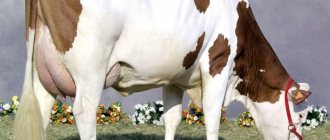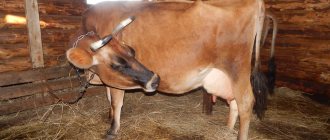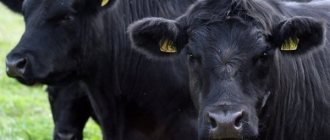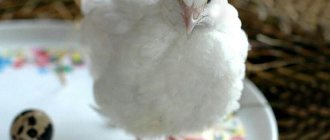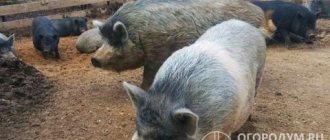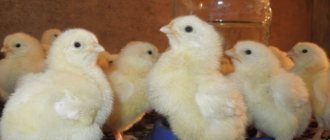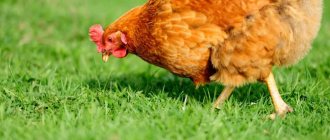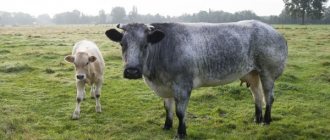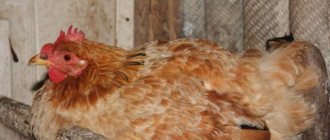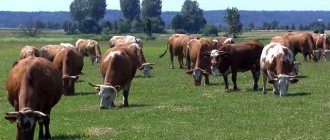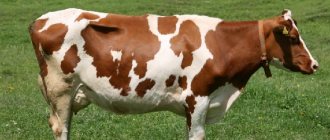Content
Kostroma Burenka is grown both on large farms and on small private farmsteads.
Well-equipped, insulated premises are also important when breeding cows. The animal's comfort affects milk yield. It should not be hot in the barn; in moderately low temperatures, milk yield is higher, as are fat content. Therefore, you should not heat the barn.
If the cow is in a large herd, and if strong noises are often heard near the barn (for example, a sawmill has been working nearby for a long time), the cow may not milk well.
The housing area must be dry, clean, ventilation is desirable, but the presence of drafts is contraindicated. In the summer, cattle are sent to graze in the meadows.
Careful care of Kostroma cows is important. They do not like being treated rudely or being shouted too loudly.
The sexual maturity of Kostroma cattle depends on the climate of the area, the conditions in which it is raised, and the diet.
Breeding
Before you start breeding cows, you should arrange a room for them. Its dimensions are selected depending on the planned livestock and the available space.
Cows are quite whimsical: from dampness, cold or stuffiness they have problems with weight and milk.
It is advisable to build a barn at a distance from the house, water sources and neighboring houses. According to sanitary standards, the building should be located 15 meters from the house, and 20 meters from wells and boreholes (to maintain the purity of drinking water).
It is best to locate the barn near the vegetable garden or orchard so that you can save time on manure disposal.
The choice of materials for construction depends on natural conditions. Most often, of course, wood is used - planed boards or logs. Brick, aerated concrete or foam concrete are also suitable for construction - materials with good thermal insulation.
For flooring, concrete is considered the ideal option due to its hygiene and durability. The adobe coating retains heat well and is comfortable, but wood is not recommended: it absorbs all odors and quickly deteriorates.
When breeding indoors, it is recommended to arrange an attic. It has many advantages:
- a convenient warehouse for hay, where it retains its beneficial properties for a long time;
- additional insulation of the ceiling;
- It is possible to throw hay from above directly into the feeder.
If the attic is not being built, the ceiling is made of tightly laid boards, coating all joints with clay and then using insulation (slag, dry earth or sawdust are suitable).
The insulation layer should not be less than 10 cm. A roofing material or slate is placed on top and a small cornice is made to prevent rainwater from flowing inside.
For one cow, the ideal barn area would be 18 square meters. m. – it’s enough for a cow with a baby and equipment with feed. If there are several cows, the size of the room is calculated based on 6 square meters. m. per head (and 9 sq. m. if there are offspring).
This area includes a feeding area and a passage. The feeder should be in front of the stall. It is also advisable to come up with a drain for waste that discharges it into a cesspool.
In the barn, ventilation must be installed at a height of 2.5 meters. You can install a special pipe for constant air flow. The pipe must have a damper against low temperatures and precipitation.
You need to start with the foundation, and for a small building, a strip type is also suitable, which will withstand a large load. In non-flowing soils, the foundation is buried half a meter. The upper part can be protected from moisture with a layer of bitumen.
Walls are built above the foundation. Brick ones are well ventilated, but you will have to use insulation. Cheap adobe brick is considered optimal, since the building will be dry and warm.
The floor should be 10 cm above ground level. A slight slope is made towards the sump. The concrete surface can be covered with wooden boards, but they will have to be removed periodically for cleaning.
At the end of the slope, a tray or groove is made, 15 cm deep and 25 cm wide. The design of the room involves reducing harmful substances in the air by removing slurry.
To do this, a manure chute is made with an inclination towards the slurry collector. From there, urine is periodically removed with a bucket. The container should be designed for a month, that is, for a cow with a calf, a tank of 1 cubic meter is sufficient.
The optimal temperature for breeding cows is 10-15 degrees.
It is important that there are no drafts inside. For ventilation, a pipe is made from boards (15x15 cm) and installed above the ridge. It is important to consider opening windows in the design.
It is recommended to place the cowshed lengthwise from east to west. The window area is 1:10 in relation to the floor area, and window openings are made higher than 1.2 m from the floor.
Health
Kostroma cows have strong immunity, so if you follow basic veterinary recommendations, you can avoid many diseases.
Vaccination helps a lot with this. Moreover, it not only helps maintain the health of the cow and calf, but is also an excellent way to protect the products obtained from cattle. Since many diseases of cows are transmitted to humans, it is necessary to vaccinate animals on farms and private farms.
Another important procedure is to test cows for brucellosis and leukemia, even though these cows have high immunity against these diseases. Vaccinations against mad cow disease, anthrax, foot-and-mouth disease and a number of other diseases are required. Products obtained from cows that have not been vaccinated are considered dangerous.
It is easy to vaccinate cows, given the many complex vaccines that have already been developed. There is a vaccination schedule. They need to be done at a certain age of the animal. The first is done to calves at 6 months. After vaccination, a set time must pass for the products to become suitable for consumption.
Characteristics
The direction of the Kostroma breed is meat and dairy. These animals have a number of distinctive features:
- Large size and strong build. The body has a lot of muscles, the head has an elongated shape and a wide forehead. The chest is well developed, the back is level and long with a wide loin. The legs are not too long, but strong and stable. The udder is developed, which does not always have a symmetrical cup-shaped shape.
- Adult females reach 600 kg, bulls - 850. This is an excellent figure compared to many other breeds.
- The color of Kostroma cows is always gray; shades can vary from light gray to brown-gray.
- There is some disagreement about the nature of these cows. There is an opinion that these are calm and friendly animals, but other farmers claim that Kostroma cows are too active and even restless. This discrepancy most likely depends on individual factors.
- Life expectancy is up to 20 years, and throughout this time, milk yield, health and endurance remain at the same level.
Breed classification
At first they tried to divide the animals according to the place of breeding into mountain and lowland ones.
The following classification is now accepted:
- Dairy (Kholmogory, Yaroslavl, Dutch, Azherol).
- Meat (Bruford, Hereford, Galloway, Kalmyk, Charolais).
- Meat and dairy or combined (Bestuzhevskaya, Kostroma, Simmental).
Each of these areas has its own subgroups. For example, dairy products differ in the fat content of their products, while meat products differ in the speed of weight gain.
The popularity of certain destinations depends on the characteristics of the cuisine in different regions. In the steppes, cow meat is consumed more often; dairy production is not developed there. But in Europe and North America, milk cows are popular.
Milking
Since milk production is always transmitted through the line of the sire, when purchasing a cow for milk, this factor must be taken into account. That is, it is important to study the pedigree of the purchased cow.
Milk yield will not work if the barn is located near some noisy place (for example, a highway).
In order to get a good high-yielding cow, the heifer needs to be mated for the first time only at 2 years old. If you cover a heifer at the very beginning of puberty, there will be no milk production - this is one of the features of the breed.
Important! Milk release is not fast - approximately 120 ml per minute.
Kostroma breed of cows
Kostroma breed cows are classified as a combined type of cattle. Representatives of this variety are distinguished by strong bones and a muscular body, have a voluminous udder, and therefore are ideal for dual use: both for meat and for milk production (Figure 1).
Distinctive external features of Kostroma cattle are:
- Slightly stretched torso;
- Long head;
- Well developed chest;
- Straight back with a wide lower back;
- Relatively short legs;
- Cup-shaped udder;
- Gray color (from milky gray to gray-brown). Most often, cows have light gray wool, while the color of bulls is darker, sometimes almost black.
Figure 1. External features of the breed
Due to its versatility, the Kostroma breed of cows is well known in private farms.
Its advantages are:
- High meat productivity: young animals are able to gain up to 1 kg 300 g per day, which is a very high indicator.
- Unpretentiousness to living conditions: such cows can fully develop even in such circumstances in which other breeds of cattle lose weight and get sick.
- Low cost of the resulting products: it is associated with minimal feed costs, since cows eat mainly grass and hay. At the same time, the products are not inferior in quality to milk obtained from expensive breeds.
- High vitality and endurance: it allows animals to quickly adapt to a new place of residence and successfully tolerate different climatic conditions.
- Low mortality of young animals: calves are born strong and healthy, and the calving process itself in most cases occurs without complications and does not require human participation.
- Long productive period: cows of the Kostroma breed are able to maintain milk yield at the age of 20 years, remaining healthy and hardy.
- Rapid adaptation to changes in climatic conditions: it is this feature that explains the wide distribution of Kostroma cows in various regions of our country.
- Unpretentiousness in nutrition: easy transition from winter to summer feeding and vice versa.
- Leather quality: Kostroma cattle have dense and strong skin, which is successfully used in the leather industry.
Along with obvious advantages, there are also significant disadvantages that hinder the breeding of this breed.
Among them:
- Low milk yield (no more than 5 thousand liters of milk per year), which cannot be corrected with the help of concentrated feed, the use of which, in this case, has the opposite effect. In addition, cows are characterized by a low rate of milk production due to the incorrect structure of the udder.
- Difficulties with machine milking, and in some cases the use of a milking machine is impossible.
- Dependence of milk productivity indicators on heat in the warm season. For this reason, breeding cows of the Kostroma breed in areas located south of Lipetsk and Tambov has been found to be unprofitable. Animals have become widespread in the central part of Russia and more northern regions: Kostroma, Ivanovo, Yaroslavl and Vladimir regions, as well as in the Mari-El Republic.
- The decrease in productivity in large herds is the reason that large livestock complexes do not practice keeping and breeding the Kostroma breed for milk production.
Based on the above, in order for the productivity characteristics to be high, it is necessary to provide the necessary conditions for keeping and feeding, which does not require large financial investments.
History and origin of the breed
Work on breeding the Kostroma breed of cattle began in the post-revolutionary years at the Karaevo state farm, where, based on local species, animals of the Babaev and Miska groups were crossed with the Swiss and Algauz species. The greatest influence was exerted by the Swiss breed, which is noticeable in the appearance of Kostroma cows.
They were kept in unheated rooms and fed abundantly. The desired result was achieved in 1940, when the highest productivity was 6310 kg of milk per year. As a separate species, the Kostroma breed was registered in 1944 and is still considered one of the best in Russia. Today the breed is divided into 14 lines, the most common of which are: Silach, Karo and Salad. Selection work continues to this day. At the same time, their main task is to increase the content of nutrients in milk, in particular proteins and fats.
Habitats
With all its merits and quite great popularity in the post-Soviet space, the Kostroma breed remains a regional breed.
Although it is bred even in Belarus and Ukraine, the main population is concentrated in the northeast of Central Russia - in the Kostroma, Ivanovo, Yaroslavl and Vladimir regions.
Animals are perfectly adapted to the climatic conditions of central Russia and more northern regions. Cows tolerate cold winters and moderately hot summers well.
History and description of the breed
The breed is quite young, its history is not even a hundred years old. However, animal productivity is invariably high both on large farm enterprises and on small private farms.
Breeding work
The goal of the breeders was to create a productive dairy cow, for which an entire state farm was created in the Kostroma region. The following breeds were taken as parent individuals:
- Babaevskaya;
- miska;
- Swiss;
- Alguzskaya
In 1944, the breed was officially registered and described.
External features
Kostroma cows have a remarkable appearance:
- height (adult at withers): average 130 cm;
- average weight: heifers 800 kg, bull 1000 kg;
- physique: wide bones and developed muscle mass;
- head: elongated with a narrow forehead, on a strong long neck;
- horns: symmetrical, ears are also located symmetrically on the sides;
- eyes: large, dark in color;
- chest: wide and developed, like the dewlap;
- back: wide, has a straight line with a slight hump at the withers, straight lumbar region;
- udder: large, convex, shaped like a deep bowl;
- limbs: straight, length proportional to the body;
- color: all variants are brown.
Selection
In the Kostroma province, back in the 19th century, work was intensively carried out to improve local cows. To do this, they tried to cross them both with Kholmogory bulls and with Swiss, Ayrshire, and Simmental breeds. This work did not lead to success, because... the animals received neither productivity nor any outstanding exterior qualities. Babaevsky and Miskovsky cattle, which were obtained as a result of such crossings, cannot even be called full-fledged breeds. A little later, already in 1910, these two quasi-breeds were crossed with foreigners again and again. The revolution did not allow us to finish what we started.
Only in 1919 did they return to breeding work again. The state took control of all work. This work was carried out at the Karavaevo state farm. It took approximately 25 years to bring what had been started to a successful conclusion, when it was finally possible to create a breed with acceptable characteristics. Cattle of the Kostroma breed began to be actively bred, and in 1940 it was already supplied outside the region. In 1944, this breed was officially approved, and it began to spread throughout Russia, as well as Belarus.
Behavior
Cow
is a herd animal. Each herd has its own dominant hierarchy, which is formed during clashes between individuals. Once established, it remains unchanged in a given herd. In general, the herd lives amicably and obeys its leader. Domestic cows use special odors and pheromones to communicate with each other. With the help of a developed sense of smell, they distinguish between the emotions of their relatives, especially fear and excitement. Head position is another means of communication. It expresses the animal’s mood (submissive, anxious). The mooing or roaring of cows serves to express suffering (with late milking), hunger, thirst, or the call of a calf or relative.
Cows spend about a third of the day grazing, another third chewing cud, and the rest of the time they rest.
General information
One of the most popular trends in livestock farming is the breeding of new breeds of cattle. The butt is a knob-shaped thickening. Some breeds of cattle have such tubercles on their heads - the rudiments of horns. Poledness is the absence of horns on the head. This feature in animals may be present under the influence of several factors:
- if the owner deliberately cuts off the horns in order to ensure the safety of the animals and reduce the risk of injury;
- such a feature can be acquired as a result of crossing certain breeds;
- genetic predisposition.
To ensure ease of keeping and to protect cows, many cattle breeders decide to deliberately cut off such growths on animals.
It is important to remember that antlers are living, so their removal must be approached with all responsibility. This procedure should only be performed by a veterinarian
Otherwise, you may cause harm to the animal's health. If a cow's horn is deliberately removed, a specialist will cauterize the bud, which is a safe and painless procedure for a one-month-old calf.
Breeders developed a breed of polled cows. This is the result of crossing a polled bull with a polled cow. Their first offspring will be hornless, but the second offspring will have the beginnings of horns on their heads. There are certain breeds of polled cows that have inherited this feature. Let's get acquainted with them further.
Russian polled cow
Vaccination is an important part of working with the Kostroma cow population
Vaccinations protect not only the health of the calf or cow. Livestock meat and milk are consumed by the population. Therefore, by vaccinating animals, the farmer is able to protect the products. This is a preventive measure against the spread of infections, some of which can be transmitted to humans. The second preventive measure is regular laboratory tests to determine whether animals are infected with brucellosis, as well as leukemia.
Like all domestic animals, cows and bulls must be vaccinated against rabies. Vaccinations against anthrax, some infections and foot-and-mouth disease are considered mandatory.
Meat and milk from animals that have not been vaccinated are considered potentially dangerous. Not only large breeders and farmers are required to regularly conduct animal research and vaccination activities. Owners of private households must have veterinary records and a passport for each animal with notes on the animal’s vaccinations and research results.
Recently, many types of effective vaccines have emerged. Both complex (simultaneous prevention of several infections) and monovalent (prevention of one infection).
There is a schedule for administering vaccines and conducting special studies depending on the age of the animal.
Routine vaccination is carried out for calves when they are 6 weeks old. There are documents from Rosselkhoznadzor that establish the procedure for vaccination, as well as the timing of slaughter of livestock and the use of milk in production after vaccination.
Table No. 3. Onset of puberty in calves
| Kostroma breed | Puberty (months) | Use in breeding (months) |
| Gobies | 8 | 14 |
| Chicks | 7 | 15 |
If the acquired cow or calf is healthy and chosen correctly, then this is an animal with strong immunity.
Important
With good feeding and timely vaccination, cows of the Kostroma breed do not get sick throughout their lives (20 years) and give good healthy offspring.
It is difficult to confuse a calf of the Kostroma breed with young animals of other species. Naturally, because of the color. And a small calf is born with a wide back, high withers, and narrow-minded. His body is elongated. Bulls have well-developed muscles. Then it develops when the animals are out for a walk. The legs are even and parallel. Older calves walk very confidently. A distinctive feature of Kostroma cattle is the funny, as if someone had tousled bangs on their forehead. The characteristics of the breed (not only milk yield) are inherited by calves through bulls.
How to choose a high-yielding cow
| Kostroma Burenka | Signs of a healthy purebred individual | Flaws |
| Backbone | Strong enough | |
| Musculature | Weak | |
| Udder | Large, bulging veins, there should be no seals | Small size, there are seals |
| Intercostal space | Widely spaced | The gaps are narrow |
| Ribs | Stand obliquely in relation to the spine | |
| Breast | Wide, deep, 1 inch below the elbow of an adult | Set on too high or too low |
| Head | Not very big, but the muzzle is elongated | Large with a short muzzle |
| Horns | Small, thin | Large, between the rings on the horns 1.5-2 cm (a sign of barrenness) |
| Neck | Abundance of skin folds | Rare folds |
| Withers | Round, low hanging | Pointed, forked |
| Back, lower back, rear | Straight line, long | The animal is hunched over |
| Sacrum | Wide, has ischial tuberosities | Narrow |
| Stomach | Volumetric, barrel-shaped | saggy |
| Legs | Tall and quite strong | |
| Leather | Thin, short, with a characteristic shine | Dim |
| Tail | Long, thin | Short, thick |
| Gait | Firm, confident | Limping |
| Eyes | Clean, no film | Inflamed |
Kostroma cows are distinguished by a uniformly developed elongated and cup-shaped, wide and voluminous regular udder. The location of all cylindrical nipples is at the same distance from each other. Yield good volumes.
Interesting
Due to the fact that this breed of cattle does not need expensive feed, but eats hay and grass, they have a low cost of production. This allows them to compete with highly productive but expensive cows.
Exterior
Characteristics of Kostroma breed cattle:
- firm, persistent gait;
- strong bones and muscles;
- elongated body;
- straight legs;
- tubercle at the withers;
- wide chest with developed dewlap, butt, lower back;
- small head with bangs;
- the horns are also small;
- the coat comes in gray, brown and dark brown shades, sometimes with a yellow stripe along the spine.
Cattle of the Kostroma breed have a small head with bangs
History of the breed
In the early 20s of the last century, the Karavaevo state farm became most famous in the Kostroma region. It was there that experiments began to develop a fundamentally new breed of cows.
The main breeds with which scientists worked were the following:
- Algauzskaya;
- Swiss;
- group of Babaev breeds;
- Kostroma miskanskaya.
The main goal that scientists set for themselves when breeding the breed was to create a new type of cows that would be distinguished by greater weight, endurance, and also produce a lot of fatty milk.
Only healthy individuals with healthy genetics and correct body shapes were selected for selection. Such care was also necessary to ensure that the new breed had good fat content and protein content in milk.
But only 20 years later, cows were bred that began to produce up to 5500–6000 liters of milk per year. And at the same time, this breed also had record-breaking cows, which produced more than 10,000–12,000 liters of milk per year with an average fat content of 3.9–4.0%. And during the war, the state farm provided a large amount of meat and milk precisely thanks to cattle of this breed.
And scientists are still working to improve the Kostroma breed. Their goal is to increase the fat content of milk, as well as extend the life of individuals of this breed.
Burenok of the Kostroma breed can be found not only on large farms, but also on private farmsteads. Individuals of the Kostroma breed have gained such popularity due to many positive qualities.
This dairy and meat breed can reach impressive sizes. Burenki weigh on average 600–650 kg, but record holders reach a mass of 800–850 kg. Bulls of this breed are much larger - from 850 to 1150 kg, individual animals can reach a weight of 1400–1450 kg.
A distinctive feature of animals of this breed is the rapid increase in muscle mass, as well as overall body weight.
The color of this breed is quite dull - different shades of gray from light to dark.
The udder is large, regular cup-shaped, the nipples are located at the same distance and have a cylindrical shape.
Quite large milk yields are obtained from one cow, but these animals are also raised for meat. Moreover, Kostroma cows do not reduce their milk yield throughout almost their entire life; this is one of their advantages.
Milk productivity
When using traditional methods of housing and feeding, a Kostroma cow is capable of producing from 3.5 to 5 thousand liters of milk per year.
If the farm operates using modern intensive technologies, then the average milk yield can reach 5-6 thousand liters. Milk has a fairly good fat content of 3.8%, protein content is about 3.5%. Milk yield 1.5 kg/min.
There have been cases of receiving 14–16 tons of dairy products per year from record holders.
Conditions of detention
The fat content and amount of milk depends on the temperature of the cow. At low living temperatures, the species produces fairly rich milk, but in small quantities. At high temperatures the opposite is true: there is a lot of milk, but it is not fat enough. Based on this, you need to find a “golden mean”.
First of all, eliminate drafts. Since the Kostroma breed of cows is not recommended to be kept in greenhouse conditions, turn on the heating in winter only during severe frosts. As a rule, the recommended temperature for keeping cows and bulls in winter is not lower than 10°C. For sleeping, provide the animals with a bed of hay.
The Kostroma cattle breed does not like heat. Therefore, take care of large windows when arranging your shed. They will be sources of light and will also allow fresh air to enter. In winter, LED lamps will be needed in the barn to provide additional light. Remember, you should not open windows in winter, as animals are afraid of drafts. Provide ventilation for air flow and saturation of the shed with oxygen.
Cleaning the barn
Place special bedding on the floor of the barn, which consists of a mixture of hay and peat. Change bedding as often as possible, as it absorbs animal waste and pollutes the environment. Try to clean the stool drainage ditch and wash the floor with water every 1-2 days. Disinfect the shed once a week using special products. Clean the ventilation every 30 days to prevent the accumulation of dust and germs. Check food and drink containers periodically and wash them if necessary.
Feeding in summer
In the summer, animals get their own food on green pastures. But cows also need to be fed. This is due to the fact that the grass contains many vitamins, but sometimes not enough protein and sugar, which are also necessary for the health of the species. One cow of the Kostroma breed eats about 25 kg of succulent and about 5 kg of feed per day.
Feeding in the cold months
In winter there are no green grasses, so the cow’s diet consists of vegetables and root crops, mixed feed, and silage. The feed is based on various grain crops, such as wheat, barley, oats. Additionally, mineral and vitamin supplements are added.
It is also useful to feed the Kostroma cow with ground vegetables and root vegetables. The most favorite and useful for the species:
- beet;
- zucchini;
- potato;
- carrot.
In addition, chalk and table salt are added to the food.
The transition from summer to winter diet should be gradual so that the animal’s intestinal microflora has time to adapt. To suppress pathogenic microflora, antibiotics are periodically added to animal feed.
Remember that the Kostroma cow quickly gets used to the schedule: sleep, eat, walk at the same time. Milk yield directly depends on this. Therefore, the correct regime, attentive attitude, and good housing conditions will have a beneficial effect on the productivity of the breed.
Offspring
Getting healthy offspring from cows is another important point. In order to ensure this, it is necessary:
- If you do not plan to get record milk yield from the cow, then you can feast the heifer when she reaches 15 months.
- The first mating at a later age has a negative impact on the weight gain of the young - calves grow worse. Also, with late insemination, there is a high probability that the heifer will not be covered the first time, and repeated insemination will be required.
- If a young heifer receives insufficient nutrition, her onset of puberty is delayed.
- The duration of heat for cows of this breed is approximately 20 days. Insemination will be from the middle to the end of the first stage, which is only 11.5-18 hours. This gives an 80% chance that the cow is inseminated.
- Cows are capable of calving on their own. As a rule, they do not need any outside help. Calves are born viable and in most cases survive.
- The reproductive function of Kostroma cows lasts until almost 18-20 years.
- Calves are born weighing 25-30 kg, sometimes large individuals weigh up to 45 kg.
Calving characteristics of the Jersey breed
The end of the Jersey cow's maturation period occurs when it is two years old. The birth usually goes well, but with minimal human supervision. Jersey cows have an innate maternal instinct, so they must immediately lick the calf. Over the entire duration of the reproductive period, the animal gives birth to 10-13 newborns, one per year.
Calving complications can appear in the form of udder mastitis due to improper milking. A calving female is highly sensitive to sounds and strangers: she may become frightened and refuse to give milk. Therefore, protect the animal from sound influences; it is better to keep animals in a soundproof barn.
Post-calving care includes milking five times a day and feeding dry food without vegetables three times a day.
The recommended regimen for watering a cow is 2 times with water at room temperature.
conclusions
- The Kostroma breed of cows is one of the leading in terms of productivity characteristics among all-purpose meat and dairy cows.
- In order to achieve their full production potential, it is important to provide the animals with quality care and feeding.
- When breeding as a business, difficulties in care may arise as a result of violations of the feeding or walking regime.
- Calving too early can lead to a decrease in the viability of the offspring , as well as a deterioration in the milk quality of the cow.
Advantages and disadvantages
The Kostroma breed is adapted to life in Russia, even in its northern regions. The best regions for its breeding are Kostroma, Vladimir, Yaroslavl and Ivanovo regions. The main advantages of the breed include:
- Meat productivity. This is due to the growth of young animals: it is up to 1300 g per day (the standard weight gain is 1 kg). The slaughter yield at the standard level corresponds to 60%.
- Unpretentiousness and the ability to live in not very favorable conditions. Cows do not require special conditions; it is enough to perform basic care procedures. Cold tolerance is even better than heat tolerance.
- Low cost. This is due to the unnecessary need for expensive and specific nutrition. Hay is the cheapest feed available and is exactly what these cows need.
- Lasting immunity. Kostroma cows do not suffer from leukemia and many other cattle diseases.
The disadvantages of the breed include:
- Not too high milk yield. As many breeders note, they amount to less than 5000 liters per year. It is quite problematic to increase them, since the abundance of concentrated feed only reduces milk yield.
- Poor heat tolerance. This does not affect the health of the animals, but again the milk yield. It is not recommended to have Kostroma cows south of Lipetsk and Tambov - they will be uncomfortable there.
- Minimum milk production in large herds is a specific problem unique to this breed of cattle.
- Not very widespread throughout Russia.
Feeding
To obtain a large amount of fatty milk, cows of the Kostroma breed need a specific diet, which should include:
- succulent feed (clover hay) - up to 18–20 kg per day;
- concentrated feed (should be 5–6 kg per day).
For dairy cows, the diet is selected individually depending on their needs. A correctly selected daily diet allows you to obtain large milk yields from each individual and thus recoup the cost of feed.
Young animals should be fed generously in order to obtain regular weight gain of up to 500–600 g per day.
During the summer season, a herd of Kostroma cows is necessarily driven out to pastures with lush grass.
The diet of Kostroma cows must be balanced in minerals and vitamins, but an abundance of concentrated feed is not only not necessary, but even contraindicated.
Unlike European dairy breeds, which increase milk yield from such feeds, Kostroma cows, on the contrary, reduce them.
The basis of the diet of Kostroma cows should be fresh hay in winter and green grass in summer. Concentrated feed is allowed in a volume equal to ¼ of the standard norm for cattle.
To increase the growth rate of young animals, they can also be fed with boiled potatoes and other vegetables.
Important care points
The process of breeding Kostroma cows took place during difficult years. Therefore, in addition to productivity indicators, the endurance and unpretentiousness of livestock to living conditions were important characteristics for breeders. But there are still special care features for the record-breaking breed.
In winter, cows of the Kostroma hardy breed need an indoor barn with clean, warm bedding and no draft.
In summer, livestock need to be provided with well-organized grazing.
For the calf, minimum living conditions are organized in an unheated room. This is done to form natural immunity and increase the resistance of individuals to adverse external environmental factors. Calves are provided with competent care and constant monitoring
Particular attention is paid to creating a diet so that the formation of a young body in the first months of life occurs harmoniously. Antibiotics are added to calves' feed to suppress pathogenic microflora and normalize intestinal function.
If the quality of mother's milk does not meet all the necessary requirements, then the quality of food is compensated with a special nutrient solution. Although this is very rare, because the quality of milk from Kostroma cows is always excellent.
The diet of adult animals is formed from different feeds - juicy, rough and concentrated. The majority should be the first two types. Otherwise, cow milk yield decreases. For dairy cows, individual feeding is selected, taking into account the characteristics and needs of each cow.
Sergey Fomin, farmer
Cows of the famous Kostroma breed appeared on our farm as soon as we decided to breed cattle. I am very pleased with the productivity and unpretentiousness of the cows, the rapid growth and good immunity of the calves. The only negative is the unusual shape of the udder and the reduced rate of milk secretion in cows.
Tatyana Vasilyeva, pensioner
The cow in our yard is a member of the family. The last time we bought a Kostroma breed heifer. I immediately came to the court. Doesn't feed and doesn't react to weather changes. Milk yield does not depend on this. There is enough milk for both us and our neighbors. We are very happy with our brownie.
This is interesting: KRS (cattle) (video)
